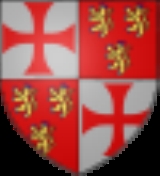
Armand de Périgord
Encyclopedia

Knights Templar
The Poor Fellow-Soldiers of Christ and of the Temple of Solomon , commonly known as the Knights Templar, the Order of the Temple or simply as Templars, were among the most famous of the Western Christian military orders...
.
He was master of the Province of Apulia
Apulia
Apulia is a region in Southern Italy bordering the Adriatic Sea in the east, the Ionian Sea to the southeast, and the Strait of Òtranto and Gulf of Taranto in the south. Its most southern portion, known as Salento peninsula, forms a high heel on the "boot" of Italy. The region comprises , and...
and Sicily
Sicily
Sicily is a region of Italy, and is the largest island in the Mediterranean Sea. Along with the surrounding minor islands, it constitutes an autonomous region of Italy, the Regione Autonoma Siciliana Sicily has a rich and unique culture, especially with regard to the arts, music, literature,...
from 1205 to 1232. In 1232, he was elected Grand Master of the Templars. He organized attacks on Cana
Cana
In the Christian New Testament, the Gospel of John refers a number of times to a town called Cana of Galilee.-The marriage at Cana:Among Christians and other students of the New Testament, Cana is best known as the place where, according to the Fourth Gospel, Jesus performed his first public...
, Safita
Safita
Safita is a city in northwestern Syria, located to the southeast of Tartous and to the northwest of Krak des Chevaliers. The city has a population of 33,000. It's situated atop three hills and the valleys between them, in the Syrian Coastal Mountain Range...
, and Sephoria, and against the Muslim positions around the Sea of Galilee
Sea of Galilee
The Sea of Galilee, also Kinneret, Lake of Gennesaret, or Lake Tiberias , is the largest freshwater lake in Israel, and it is approximately in circumference, about long, and wide. The lake has a total area of , and a maximum depth of approximately 43 m...
. All of these expeditions were failures and diminished the Templars' effectiveness.
In 1236, on the border between Syria
Syria
Syria , officially the Syrian Arab Republic , is a country in Western Asia, bordering Lebanon and the Mediterranean Sea to the West, Turkey to the north, Iraq to the east, Jordan to the south, and Israel to the southwest....
and Cilicia
Cilicia
In antiquity, Cilicia was the south coastal region of Asia Minor, south of the central Anatolian plateau. It existed as a political entity from Hittite times into the Byzantine empire...
, 120 knights, along with some archers and Turcopole
Turcopole
In the Crusades, turcopoles, turcoples, turcopoli or turcopoliers were locally recruited mounted archers employed by the Christian states of the Eastern Mediterranean.-History:...
s, were ambushed near the town of Darbsâk (Terbezek). In the first phase of the battle, the Templars reached the town but they met fierce resistance. When reinforcements from Aleppo
Aleppo
Aleppo is the largest city in Syria and the capital of Aleppo Governorate, the most populous Syrian governorate. With an official population of 2,301,570 , expanding to over 2.5 million in the metropolitan area, it is also one of the largest cities in the Levant...
arrived, the Templars were massacred. Fewer than twenty of them returned to their castle in Bagras
Bagras
Bagras or Baghras is the name of a town and nearby castle in İskenderun district of present-day Turkey, in the Amanus Mountains.The castle, properly known as Gastun provided a base for a force to cover the Syrian Gates, the passes between İskenderun and Antioch...
, fifteen km from the battle.
In September 1239, Armand arrived at Acre. He made a treaty with Sultan of Damascus
Damascus
Damascus , commonly known in Syria as Al Sham , and as the City of Jasmine , is the capital and the second largest city of Syria after Aleppo, both are part of the country's 14 governorates. In addition to being one of the oldest continuously inhabited cities in the world, Damascus is a major...
, in parallel with the Hospitaller
Knights Hospitaller
The Sovereign Military Hospitaller Order of Saint John of Jerusalem of Rhodes and of Malta , also known as the Sovereign Military Order of Malta , Order of Malta or Knights of Malta, is a Roman Catholic lay religious order, traditionally of military, chivalrous, noble nature. It is the world's...
treaty with the Sultan of Egypt. In 1244 the Sultan of Damascus demanded that the Templars help repel the Khwarezmians from Asia Minor
Asia Minor
Asia Minor is a geographical location at the westernmost protrusion of Asia, also called Anatolia, and corresponds to the western two thirds of the Asian part of Turkey...
. In October 1244, the Templars, Hospitallers and Teutonic Knights
Teutonic Knights
The Order of Brothers of the German House of Saint Mary in Jerusalem , commonly the Teutonic Order , is a German medieval military order, in modern times a purely religious Catholic order...
, together with the Sultan of Damas, confronted with Sultan of Egypt and his Khwarezmian allies at the Battle of La Forbie
Battle of La Forbie
The Battle of La Forbie, also known as the Battle of Harbiyah, was fought October 17, 1244 – October 18, 1244 between the allied armies and the Egyptian army of the Ayyubid Sultan as-Salih Ayyub, reinforced with Khwarezmian mercenaries.-Prelude:The capture of...
. The Christian-Muslim coalition was defeated, with more than 30,000 deaths. Some Templars and Hospitallers reached Ascalon
Ashkelon
Ashkelon is a coastal city in the South District of Israel on the Mediterranean coast, south of Tel Aviv, and north of the border with the Gaza Strip. The ancient seaport of Ashkelon dates back to the Neolithic Age...
, still in Christian hands. Armand de Périgord may have been killed during the battle, but may have been captured and survived until 1247.

